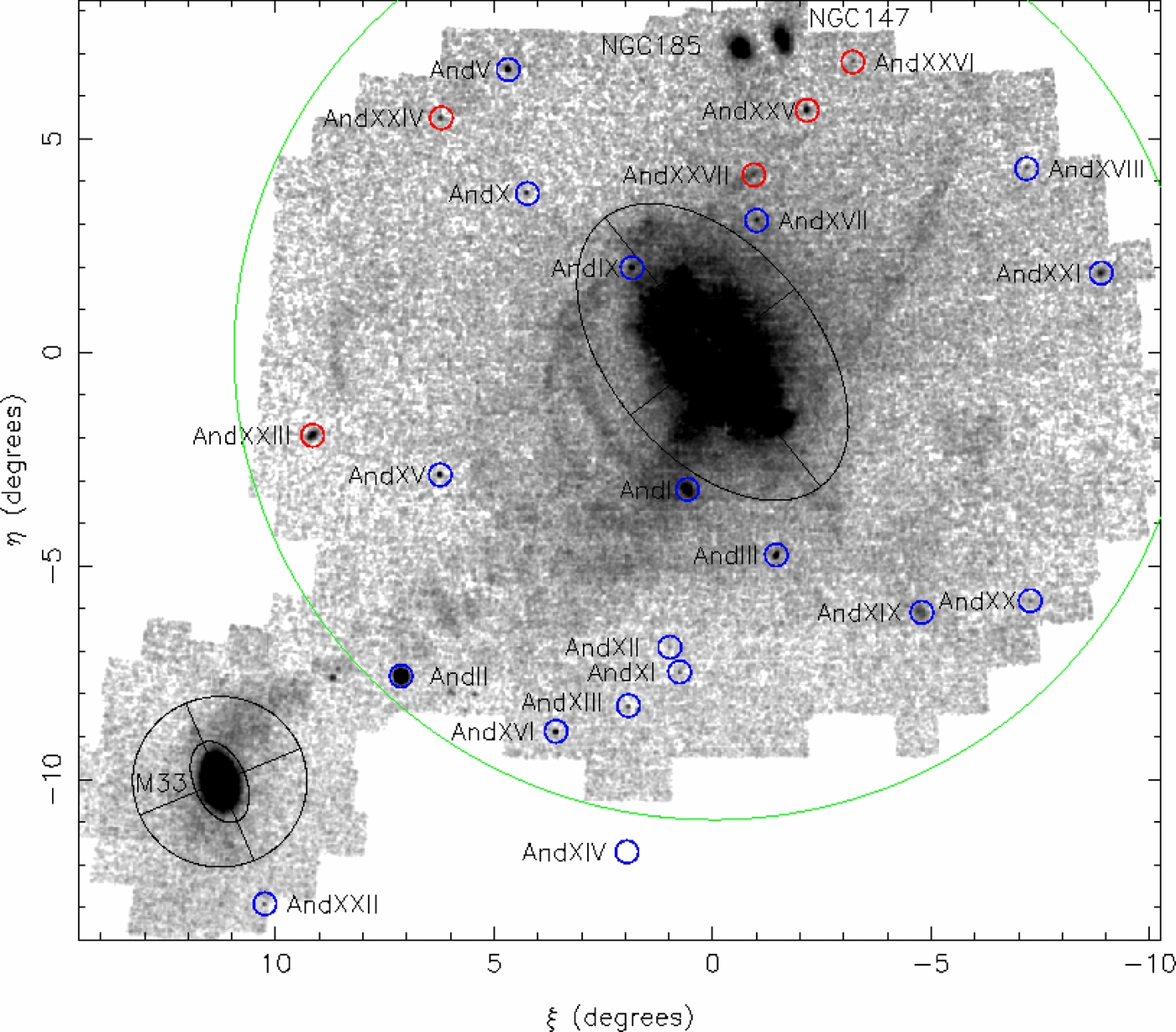Radio Astronomers Discover Small Clouds of Intergalactic Gas in the Local Group
A team of astronomers led by Spencer Wolfe and D.J. Pisano of West Virginia University have used the Green Bank Telescope of the National Radio Astronomy Observatory to survey for diffuse atomic hydrogen gas in the region between the Local Group galaxies M31 (Andromeda) and M33 (Triangulum). They identify a number of small gas clouds that are not associated with any known concentrations of stars. This places these objects in a new category that is not quite like any other known. Their report appears in the May 9 issue of Nature.
It has been known for about a decade that there is some gas in the mostly empty space between M31 and M33, but nothing is known about how it came to be there or whether it was fated to fall into the large galaxies. The latter question is important to whether galaxies like our own Milky Way can acquire new gas to continue to feed their current rate of star formation. If not, we may happen to live in an epoch when giant galaxies consume the last of their fuel and the lights start to go out.
The early observations indicated only a diffuse band of gas potentially bridging the space between M31 and M33. Such features can arise as the result of interactions between galaxies, in which gas is liberated by strong gravitational perturbations. Alternatively, simulations of structure formation suggest that primordial filaments connecting galaxies might be common. Neither of these plausible interpretations obviously apply to the new observations.

|
Fig. 1. The Local Group galaxies M31 (Andromeda, top right) and M33 (Triangulum, bottom left). A diffuse bridge of gas possibly linking the two has been known for a decade (artist's conception in red). This material resolves into discrete clouds in the region (box) surveyed by the Green Bank Telescope.
Image credit: Bill Saxton, NRAO/AUI/NSF.
|
The new survey with the Green Bank Telescope shows rather surprisingly that much of the material resolves into discrete clouds of gas (Fig. 1). Rather than a diffuse intergalactic filament, there are a series of small gas clouds. Weighing in at about 100,000 solar masses each, these objects are about the same size and mass as the smallest dwarf satellite galaxies. Such dwarfs are notoriously devoid of gas; the newly identified gas clouds appear to lack any associated stars.
One possibility is that the gas clouds are primordial: in effect, dwarf galaxies that never formed stars. Astronomers have sought such objects for decades without success. While there are examples of galaxies that are more than 90% gas, there always seem to be at least some stars present - until now.
The new observations cannot by themselves confirm that these objects are self-bound galaxies, or simply intergalactic gas clouds. In either case, it is hard to imagine how the gas has remained confined for a Hubble time. Galaxies are thought to reside in dark matter halos whose gravity might contain them, though objects this small should have evaporated when the entire universe re-ionized after its first billion years. Conceivably the gas is only now condensing into the small dark matter halos that are thought to be ubiquitous in the vicinity of larger galaxies. However, it is unclear why this would be going on here and not elsewhere in the Local Group. If there is no dark matter to contain them, the presence of the clouds implies containment by a hotter, more diffuse medium of ionized gas. Such a circum-galactic medium is certainly possible, and even expected at some level. It appears that a rather robust medium would be required to confine these clouds, and it remains unclear why they would be here and not elsewhere.

|

|
Fig. 2a. Stellar material, including dwarf galaxies (small circles) and a diffuse stellar bridge in the environs of M31 and M33.
Image credit: Alan McConnachie and the PAndAS survey team.
|
Fig. 2b. An overlay of the stellar material at left with the radio image above. The new gas clouds are not associated with any of the known stellar structures in the halo of M31.
Combination of the other two images by Stacy McGaugh.
|
Tidal interaction remains a possibility. There is plenty of stellar debris in the vicinity of M31 that is suggestive of some tidal interaction or merger (Fig. 2a). The gas clouds are offset from the stellar debris (Fig. 2b), but such segregation can occur naturally in galaxy-galaxy interactions. What is less natural is for tidally liberated gas is to clump into knots like the ones observed. Rather, one expects such gas to form long tidal streamers that lack the self-gravity to clump up. It is also not obvious whether an interaction could have occurred recently enough to overcome the containment issue.
Regardless of the ultimate interpretation of these newly identified clouds, it is remarkable that new and different objects remain to be discovered in our own cosmic back yard. The universe retains its power to surprise and amaze.
Sadly, the National Science Foundation is seeking to close the Green Bank Telescope, a modern facility that is uniquely able to perform this science. In these budget conscious times, we seem to have difficulty balancing our priorities between constructing expensive new facilities and shouldering the more modest but less glorious burden of continuing to operate the ones we've got.


